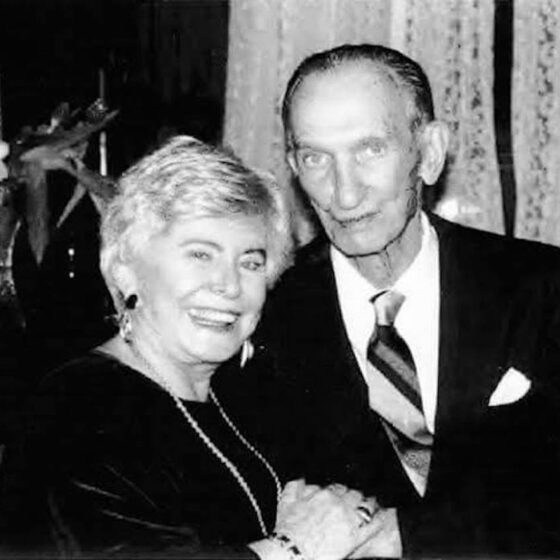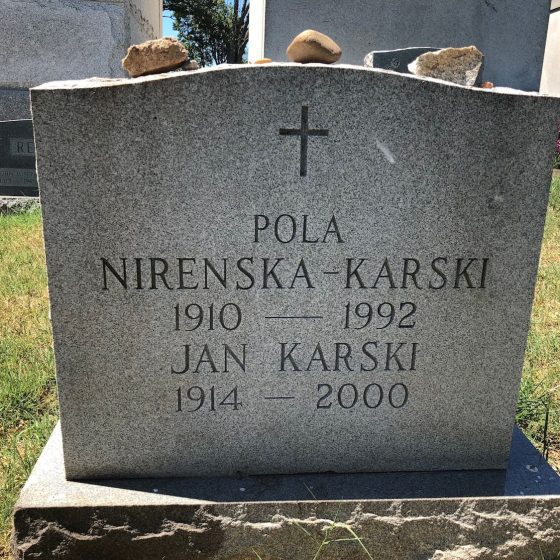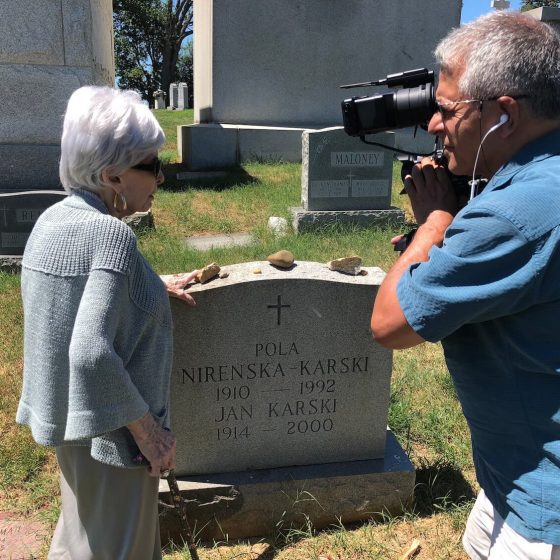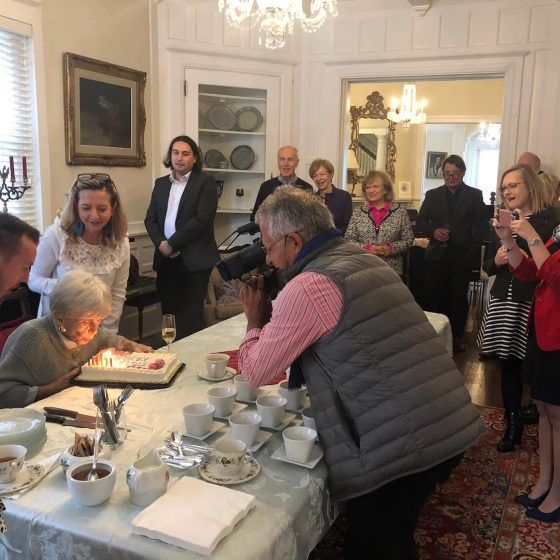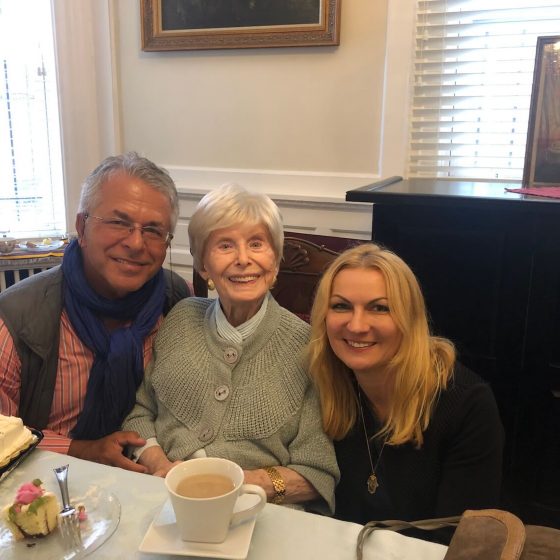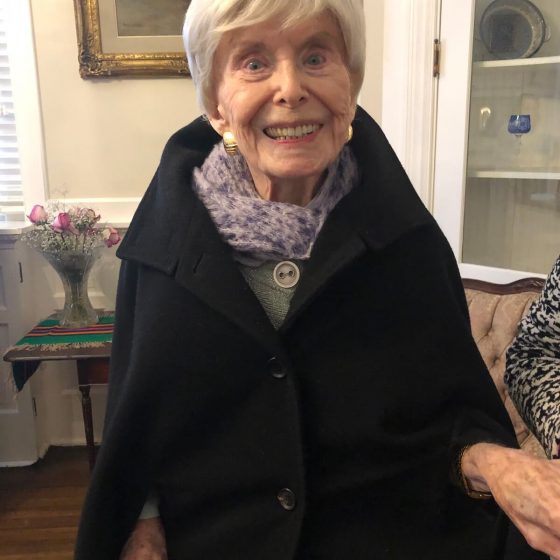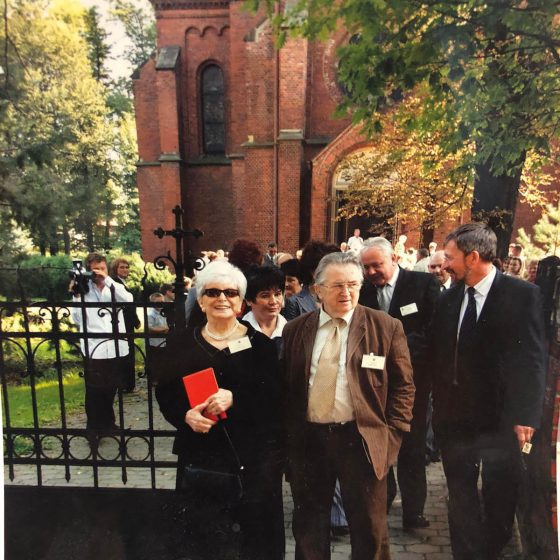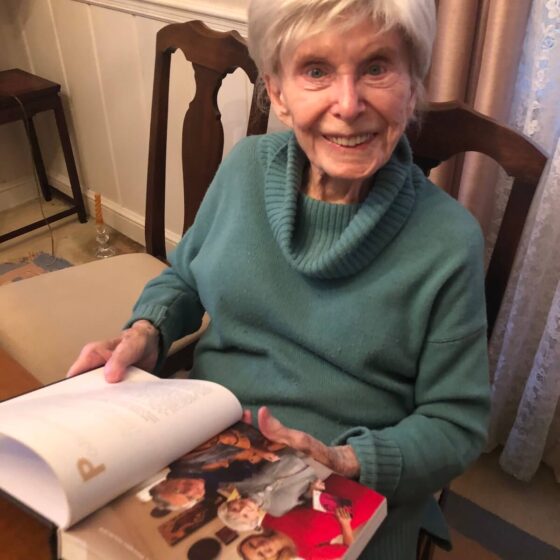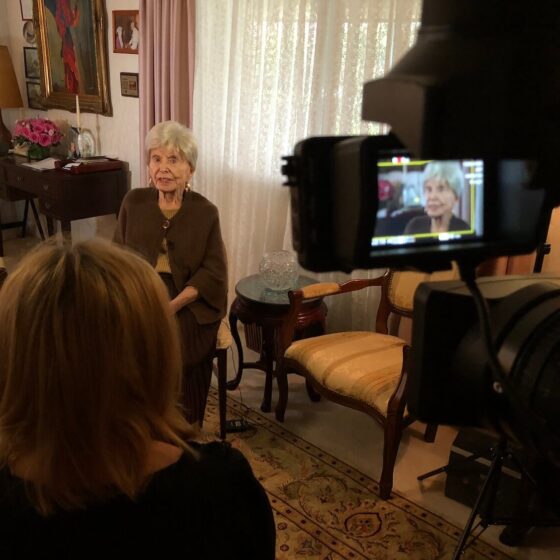EVERYTHING IS IN YOUR HANDS (Ja, Kaya – Dziołcha Ze Śląska)
Kaya Mirecka-Ploss was closely associated with Jan Karski to whom she dedicated the book “Jan Karski – the Man to Whom I Told the Truth”. She helped over a hundred children from Poland get education in the USA. She gave home to three of them, funded her studies in the US, and help them in the transition into adulthood. Read more below.
ABOUT FILM
CREDITS
STARRING
FILM POSTER
ABOUT THE PROTAGONIST
DIRECTOR'S EXPLICATION
INTERVIEWS
ABOUT FILM
“Everything Is in Your Hands” is the story of a 97-year-old Polish woman who was born in Piekary Śląskie named Kaya Mirecka-Ploss, née Hanna Adela Czech.
Sławomir Grünberg, screenwriter and director of the film, focuses on Kaya’s exceptionality, determination and charisma, the attributes that allowed her to not only change the life of Polonia in the US, but also to bring 105 Polish children to the US – to open for them a window to the world and develop their perception of it. She gave three of them a home, funded their university education in the States and ensured their proper entry into adulthood: Lidia Magdalena Lechowska, taken under Kaya’s wing from a Łódź children’s home, Maciej Frączek from Jedwabne and Katarzyna Frączek. Who are they today? How did one person change their lives forever? Why is it so important to Kaya that she was born in Silesia? What was her connection to Jan Karski, whom she continued to take care of till the end of his life? Why has American Polonia declared her one of the most important Polish émigrés? The viewers will find the answers to these as well as many other questions in the film.
Duration: 56 minutes
CREDITS
Director/Co-Producer/Cinematography:
Slawomir Grünberg
Written by:
Slawomir Grünberg
Editor:
Monika Maruszczak
Original Score:
Grzegorz Kapołka, Dariusz Ziółek
Producer:
Barbara Grünberg, LOGTV Films Polska
Co-Producers:
Silesia Film and LOGTV, Ltd.
Post-production:
Tomasz Dziedzic, HALO MEDIA
STARRING
In order of appearance:
Katarzyna Frączek
Maciej Frączek
Nina Korab-Laskowska
Krzysztof Kozak
Jolanta Kwaśniewska
Aleksander Kwaśniewski
Lidia Magdalena Lechowska
Kaya Mirecka-Ploss
Ryszard Schnepf
Joanna Witkowska
FILM POSTER
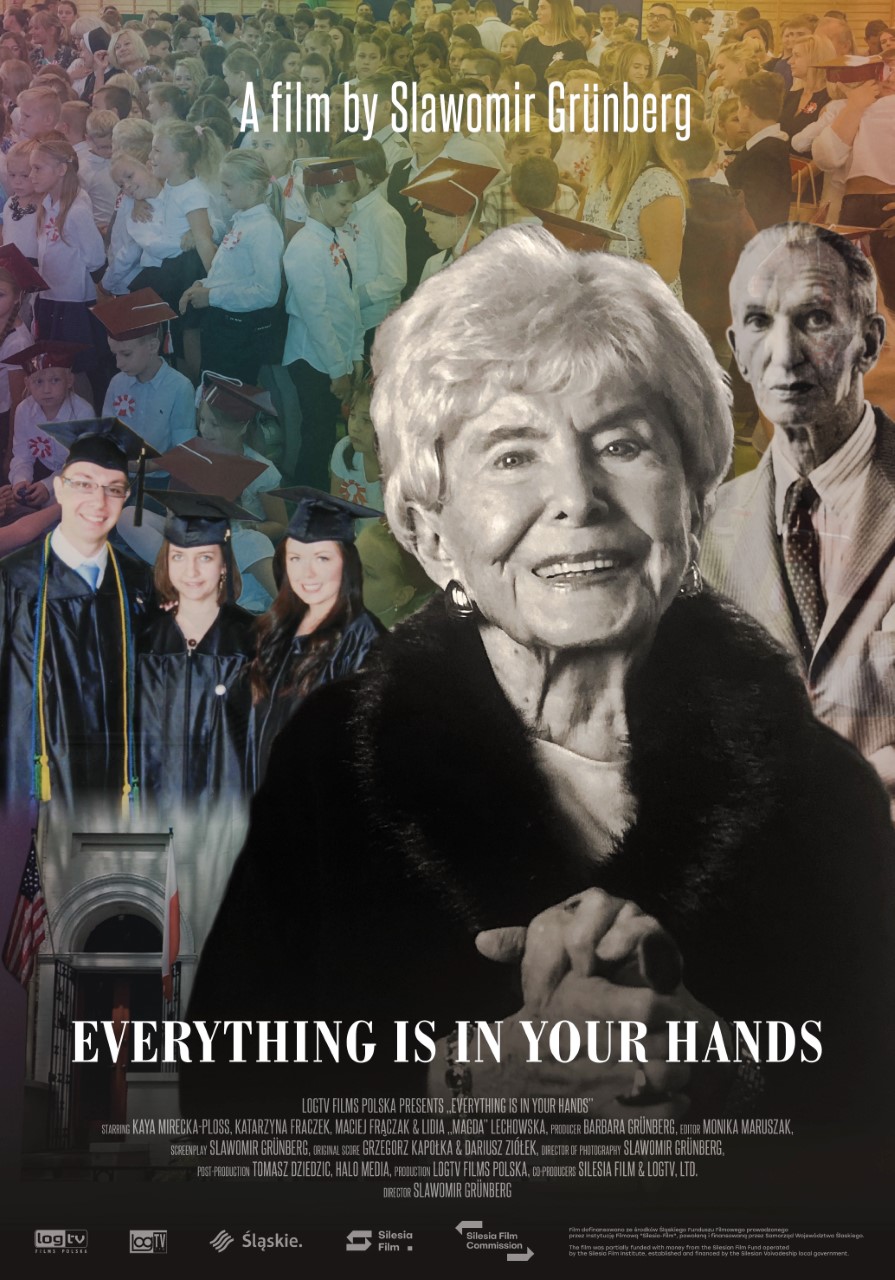
ABOUT THE PROTAGONIST
Kaya Mirecka-Ploss, née Hanna Adela Czech, was born on the 12th of September 1924 in Piekary Śląskie.
She made her name as a writer and fashion designer, but most of all as a social activist and great patriot. She always said of Poland that it’s her great love.
She spent her childhood in Nakło Śląskie and attended the school there (now known as the Kaya Mirecka Primary School). Her father, Wiktor Czech, was a locksmith and her grandfather an organ player. She spent the war in the Dachau concentration camp as a minor, where she endured traumatic experiences which she was only able to talk about many years later.
She spent her postwar years abroad, mostly in England, where she arrived in 1946 together with the Dramatic Theater of the II Corps. She finished her exams and acquired her master’s degree in London at the Saint Martin’s College of Arts fashion department.
After 15 years abroad, in late 1957, she returned to Poland where she was employed at the Dramatic Theater in Warsaw. She worked as a fashion designer and was one of the co-founders of the Moda Polska stores, which were well known throughout the country. In late 1960, she came under the scrutiny of the communist Security Service and after refusing to compromise her friends, the co-founders of Radio Free Europe, she was arrested. She was released after two weeks thanks to the help of Leon Kruczkowski, a family friend. This was when she began to write the first chapters of her book A Road Across the Bridge.
In 1966, she escaped to the United States with the help of her friend from London, the well-known Sovietologist (and her future husband) Sidney Ploss. In 1989, she was the head of the American Council for Polish Culture. In 1991, she became the executive director of the American Center of Polish Culture in Washington, D.C. At the Center, she organized the Jan Karski Room and founded a stipend in his name.
In 2011, she was an honorary guest at the opening of the interactive Study of Prof. Jan Karski at Ruda Śląska, which she initiated with the donation of Karski keepsakes.
She formed a close bond with Jan Karski, the legendary courier of the Polish Underground State, her great friend after whom she wrote a book titled Jan Karski – The Man to Whom I Told the Truth. She took care of him till the end of his life.
She is also the author of the book “The Woman Who Saw Too Much”.
She received the Commander’s Cross of the Order of Polonia Restituta and is also a Knight of the Order of the Smile, which she received on the 15th of February 2015 in Washington.
DIRECTOR'S EXPLICATION
Making movies is for me not only a search for answers to difficult questions, but also an attempt to capture life just the way it is. It’s a journey I take the viewers on in order to unveil a new and unfamiliar reality. The camera is a wonderful tool for such discoveries.
I don’t treat documentary films as a source of entertainment. If a film doesn’t bring knowledge of the world, broaden viewers’ horizons or suggest the urgency of changing the world, it isn’t worth the effort put into making it.
I’m an independent filmmaker, living and working in the United States since 1981, where I’ve directed and produced over 47 films. My films touch on topics which are often difficult, sensitive and ambiguous. I want to evoke feelings in viewers and make them think. I enjoy challenges.
The screenplay of my documentary film “Everything Is in Your Hands” makes use of modern footage and archival materials involving the film’s protagonist, Kaya Mirecka-Ploss, and the three young individuals who, thanks to Kaya, received a full academic education in the US, as well as people who are either directly or indirectly involved with her professional and private life.
Kaya Mirecka-Ploss’s incredible biography plays a pivotal role in the film. Her life experiences could be the base of a multitude of documentary films as every step of her biography deserves further exploration. Another major theme of the film is Kaya’s devotion and commitment to children. She was able to bring 105 Polish children to the United States and she made efforts to help three of them develop their outlook on life by giving them a home, financing their education in the US and ensuring their proper entry into adulthood.
The film that I offer is a journey throughout the amazing and rich life of Kaya Mirecka-Ploss, a spirited 97-year-old woman, writer, head of the House of Polish Culture in Washington, a great social activist, but also a rebel, prisoner at the labor camp in Dachau and an emigrant. The audience will have the chance to see our hero in various situations throughout her life and will meet “Magda,” taken under Kaya’s wing from a Łódź children’s home, Maciej from Jedwabne and Kasia – now young adults – and learn how one person was able to change their lives.
I’m certain that the film Everything Is in Your Hands will have no trouble finding an audience and will speak to people of all ages: members of the older and middle generations, as well as youth. What I want is for the film to not leave the viewer indifferent. I address this film to both those who never heard of Kaya Mirecka-Ploss as well as those who know her as a great figure in the cultural world, who can now complete their perception of her with the image of a sensitive woman, a sharp observer of reality, who didn’t pass by those in need with indifference.
The knowledge that a film can have great power and be capable of “changing the world” is one of the most important reasons why working on documentary films is such an exciting and worthy pursuit. The films that I go to the trouble of making are often difficult, and the issues that they touch upon sensitive and ambiguous. It’s good if they are unsettling, I believe in discomfort, the kind that is constructive and prevents conflict. I hope that Everything is in your hands is going to be the kind of film which will make every viewer reflect on the human condition in the world and think about what’s important in life and what shapes us into who we are.
Filmmaking is a grand adventure and the most thrilling part in the work of a documentary maker is making unexpected discoveries. I’m convinced that, using my camera, I’ve been able to discover incredibly interesting and, up to this point, unknown stories from the protagonist’s life, which I present in the form of a film essay – openly, honestly and without censorship. Life showed no mercy to Kaya – she experienced rapes and was tied to two murders. I’m convinced that “Everything Is in Your Hands” is an important film because it tells not only the story of a social activist, Catholic and humanist but also that of a courageous, incredibly hard-working and often non-compromising woman who was born in Silesia, a fact she often stresses.
Sławomir Grünberg
INTERVIEWS
What does your inspiration with Kaya’s character stem from? When was it that you learned about Mirecka-Ploss?
I heard about Mirecka-Ploss for the first time from Tom Wood, the author of a book about Jan Karski. When I was interviewing him in his apartment in Nashville, Tennessee, about the subject of my film “Karski and The Lords of Humanity”, Tom told me about Kaya for the first time. He told me that I must contact her, as she has the intellectual rights to Jan Karski’s legacy and her help may be crucial in the making of the film. At the same time, Tom described Kaya to me as a person who was difficult and with steadfast beliefs. You could say that he prepared me for the eventuality that meeting and talking to her could be quite the challenge. When I visited Kaya at her apartment in Bethesda in Washington for the first time, and this was over ten years ago, Tom’s warnings quickly proved unnecessary. Not only did Kaya turn out to be a warm and open person but she also immediately began to help me work on the film about Jan Karski. Not only did she make her apartment available for conducting interviews, but she also actively took part in seeking funds for the film’s production. That’s also when I shot my first interview with Kaya in her apartment. During the production of the film about Karski, which lasted seven years, I visited Kaya on multiple occasions; I’d stop by and I even was allowed to sleep on the bed in the room that belonged to Jan Karski. One could say that during my work on this film, I got to know Kaya better and better, about her specific relationship with Jan Karski as well as her own amazing story. That’s when I first thought about making a movie about Kaya, but for a long time, that remained merely an idea, as I was working on other projects. Every time that I visited Kaya, she was surrounded by young people from Poland, who occupied all of the rooms in her house and who very clearly regarded her with great respect. There was something special about Kaya’s relationships with the young people that she’d bring over from Poland who would stay at her place. It is worth bearing in mind that her passion for educating Polish youth was truly special and endearing. Perhaps it was this observation that had planted the seed, the idea that Kaya – with her one-of-a-kind personality – should become the subject of a documentary film and why that goal has come closer to fruition.
There were many people I knew personally who had plans to make a film about Kaya, but aside from good intentions, nothing ever came of them. There were some interviews, some establishing shots, and even a screenplay for a feature film, but it never got made, and Kaya now is over ninety years old.
What did the beginning of your work on the film about Kaya look like and what posed the greatest difficulty when making it?
It’s not often the case that you meet a person who’s just made for the camera, whose story must be told. Kaya is that kind of a person, and the fact that finally a film was made about her was the initiative of my wife, Basia Grünberg, who became friends with Kaya and really came to like her. Kaya even told Basia after one of our visits: “I’ll let you make a movie about me, because I see that you are just like me – meaning that when there’s something that you want to achieve, you will succeed. You’ll produce it, find the funds, and Sławek will direct it.” Kaya was already 93 years old when we started shooting the film. At the same time, I already had many hours of footage involving her from various other times, including the aforementioned interview for the film about Karski which never got used in that film. Those materials proved to be invaluable.
Besides finding the funds for the film, which is always difficult and time-consuming, and which Basia dealt with, finding the archival materials, which were spread out throughout the world, took me quite some time.
How long does it take on average to make a documentary film? How long does its production last?
Typically, it takes about two to three years to shoot a documentary film. I have made films in the past, like the one about Karski, that took close to seven years to make, but it’s worth remembering that I often work on many films at the same time. I’ll start one film while another is, for example, at the post-production phase. The film about Kaya took about three years to make.
How do you choose the topics for your films?
I’ve lived and worked for nearly 40 years in the United States, where as an independent filmmaker, I’ve solely focused on making documentary films. If my films are able to prompt discussions and lead people to discovering something new or, perhaps, even changing, that’s just great. After all, we live in order to leave a worthwhile mark after ourselves and I try to accomplish just that through my films. I seek out universal characters, timeless figures who could become role models for younger generations in the States, Poland and the whole world.
Young people by nature seek out meaning in their lives and true moral role models, and “Everything Is in Your Hands” proves that sometimes it’s worth asking yourself the perhaps banal sounding question “Am I – as an individual – capable of changing the world?”
How do you choose your crew?
In this respect, every film has its own story. I seek out professionals but also those who are passionate, who want to work on films which sometimes can take very long to make, because, say, for a long time there are no funds, but the work must continue. Grants have to be written, research needs to be conducted, on-location scenes need to be shot. Working on a documentary is an adventure but it also takes commitment and determination, and these are the traits that my associates need to have. Luckily, while working on this film I got to work with Tomek Dziedzic’s incredible team from HALO MEDIA from Katowice, as well as with the great musicians from Imielin – the jazz-blues guitarist Grzegorz Kapołka and the bassist Darek Ziółek. Working with editor Monika Maruszczak, who’s also from HALO MEDIA, also went exceptionally well.


